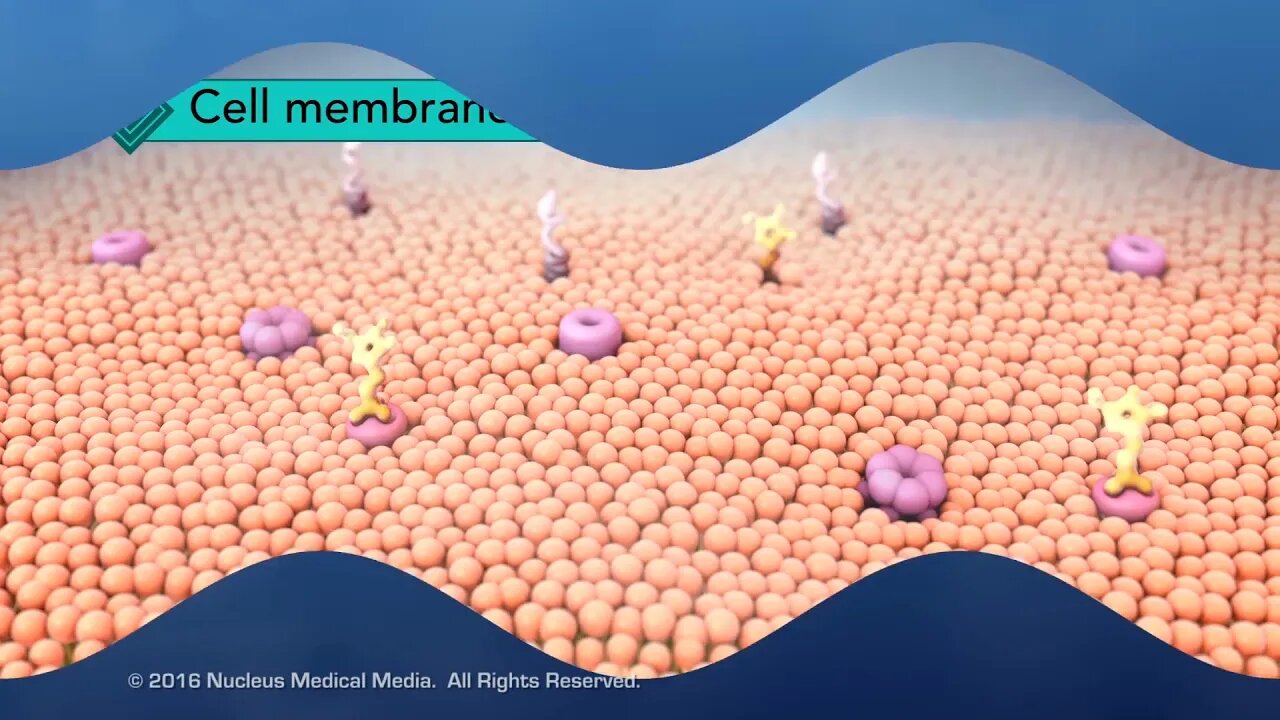Premium Only Content

Structure of the Cell Membrane
For Employees of hospitals, schools, universities and libraries: download up to 8 FREE medical animations from Nucleus by signing up for a free trial at: http://nmal.nucleusmedicalmedia.com/biology_youtube
SCIENCE ANIMATION TRANSCRIPT: In this video, we will be discussing the structure of the cell membrane. When scientists looked at the selectively permeable cell membrane, they described its structure as a fluid mosaic. You might know that a mosaic is a picture made up of little tiles. Like a mosaic, the cell membrane is made up of different parts as well. The cell membrane has two layers of phospholipids referred to as a lipid bilayer. The lipid bilayer isn't rigid. The phospholipids in it have the ability to move in a flexible wave-like motion. Let's take a closer look at a few phospholipids. The round head portions are hydrophilic, which means they're attracted to water. Both the extracellular fluid, meaning fluid outside the cell, and the cytoplasm inside the cell are mostly made up of water. So, the hydrophilic phospholipid heads of the outer layer will be oriented toward the extracellular fluid. And the heads of the inner layer will be oriented toward the cytoplasm. The phospholipid tails are hydrophobic, which means watery areas withheld them. So they orient toward each other in a direction as far away from the watery content as possible. There are also scattered proteins embedded in the phospholipid layers, some with carbohydrates attached. So, in the fluid mosaic model, the cell membrane is made up of different parts. And these parts make up a flexible boundary around the cell. But how do the majority of substances get in our out of the cell? Some molecules sip through the little spaces in between the phospholipids, which make up the majority of the semi-permeable cell membrane. However, other molecules are too big to fit through the cell membrane this way. So, how do these larger molecules pass through the cell membrane? The molecules move through proteins embedded in the cell membrane, either from the extracellular area into the cell, or from the intracellular area out of the cell. These substances will move through tunnels made up of these proteins. We'll explore how things move through the cell membrane in greater detail separately. [music]
NSV15005
-

Russell Brand
3 hours agoStay Free LIVE from AmFest — Turning Point USA - SF665
9.18K2 -
 1:11:26
1:11:26
Kim Iversen
4 hours agoTrump Pulls War Fake-Out…Attack on Venezuela Still Coming!?
32.8K39 -
 2:04:53
2:04:53
Redacted News
2 hours agoPutin just changed EVERYTHING with this move and NATO can't do anything | Redacted w Clayton Morris
124K78 -
 25:22
25:22
DeVory Darkins
2 hours agoTrump scores MAJOR WIN after Inflation Report as his speech sparks EPIC MELTDOWN
24K36 -
 1:01:23
1:01:23
Nick Freitas
4 hours agoLIVE at America Fest!
22.4K2 -
 1:11:19
1:11:19
vivafrei
4 hours agoCandace Owens' Backtracks? Brown University Cover-Up? Bongino Leaves! Pfizer Makes LEGAL ADMISSIONS?
109K60 -
![[Ep 813] LIVE from Rumble Set at AmFest 2025 | Guests Vem, Midnight, & Kevin Smith](https://1a-1791.com/video/fwe2/31/s8/1/4/F/c/J/4FcJz.0kob-small-Ep-813-LIVE-from-Rumble-Set.jpg) 56:22
56:22
The Nunn Report - w/ Dan Nunn
5 hours ago[Ep 813] LIVE from Rumble Set at AmFest 2025 | Guests Vem, Midnight, & Kevin Smith
41K3 -
 29:58
29:58
Stephen Gardner
5 hours ago🔥IT'S BAD! NEW report just DROPPED!
43.5K32 -
 LIVE
LIVE
LFA TV
20 hours agoLIVE & BREAKING NEWS! | THURSDAY 12/18/25
984 watching -
 LIVE
LIVE
freecastle
7 hours agoTAKE UP YOUR CROSS- A man’s heart PLANS his way, but the LORD DIRECTS his steps!
56 watching